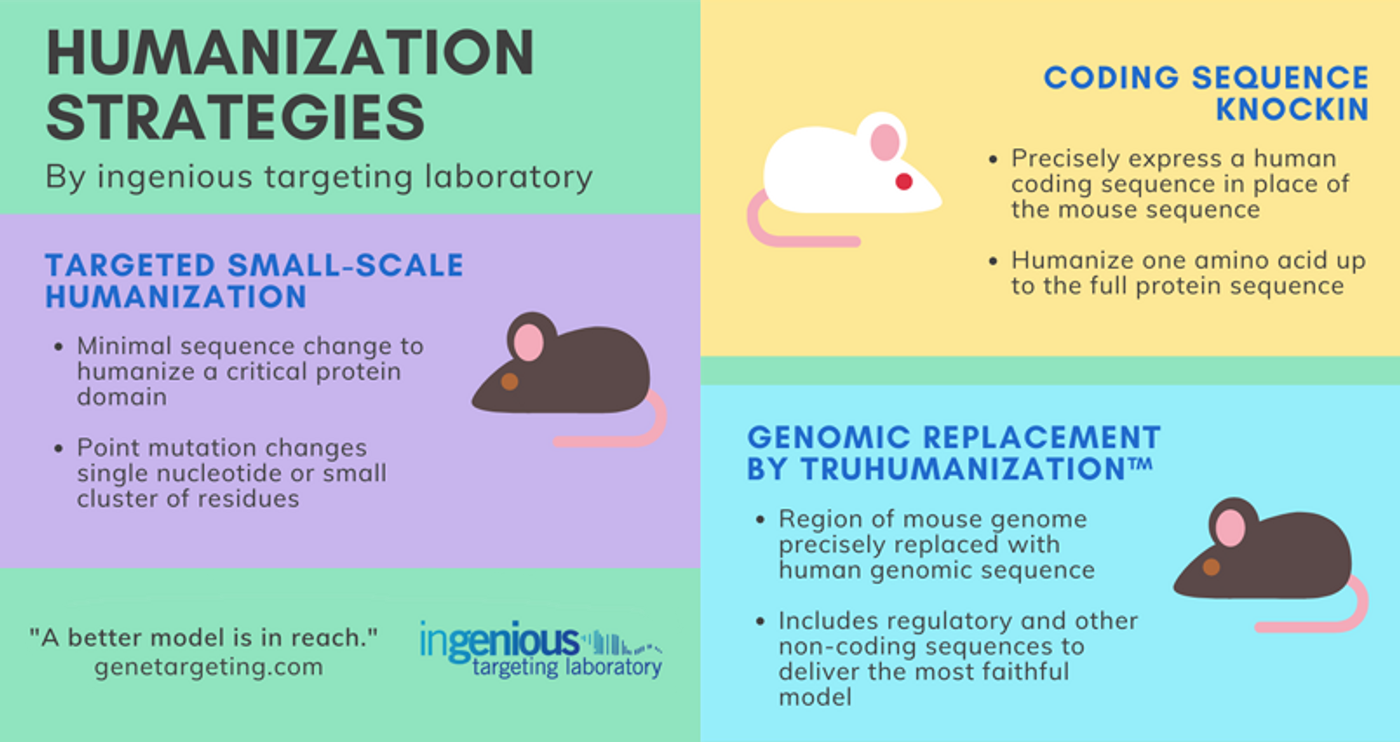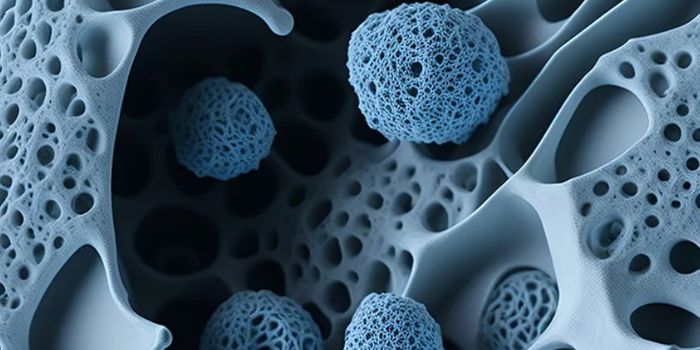History of Creating Genetically Humanized Mice
Animal research models are only as effective as their ability to simulate human disease. Depending on the condition being studied, researchers were at one time limited to available species that could naturally match the course of disease progression. This severely impacted the scope of research studies, especially if the animals required to model human disease, such as the pig, were large and/or expensive to house. The ability to genetically alter animal models became available in the 1980s and largely eliminated this potential limitation. Finally, research teams could successfully engineer animal models that better mimicked human disease in systems that were much easier to manage and maintain. The mouse, for example, is now the most popular animal model among researchers because they multiply quickly, have short lifespans of about one year, and are less expensive to house in research facilities compared to larger animal models. With this, researchers were able to better understand the pathology of human disease and more reliably translate that research into new therapies by genetically humanizing animal models, or making model organism physiology more like a human by incorporating functioning human genes into the mouse.
Historically, genetic humanization of model organisms was achieved through one of two methods: random insertion transgenic humanization and targeted genomic humanization. Random insertion transgenic humanization technology for the mouse was introduced in the 1980s and allowed researchers to randomly insert human genetic material, which could include an entire gene and its promoter, into the mouse genome. While this method is relatively fast and low cost, it has several disadvantages, including:
- the potential insertion of transgenes in multiple locations and copies in the mouse genome,
- the required segregation of transgenes to a single allele through breeding, and
- the possible disruption of mouse genes near the transgene insertion site(s).
In contrast, targeted genomic humanization removes much of the uncertainty associated with random insertion of human transgenes by inserting a single copy of a transgene at a desired location in the host. The process is more complex, expensive, and time consuming, but the transgene insertion is predictable and results in easier breeding. This strategy is typically used to replace the first exon of a mouse gene with the corresponding cDNA of a human gene, simultaneously inactivating the mouse gene and introducing the human gene for expression driven by the existing mouse promoter. The primary disadvantage of this method is its artificiality of regulation: any pre-mRNA splicing regulation that may have occurred in the human gene is lost and 3’ UTRs are typically not included in transgenes.
In order to eliminate the limitations of current genetic humanization methods in mice, ingenious targeting laboratory developed its TruHumanizationTM technology to provide fast, targeted, single-step insertion of human transgenes of up to 200kb into the mouse genome. This allows researchers to insert all of the regulatory sequence they require—including full and partial genes, promoters, introns, miRNA regulatory sites, and UTRs—to drive expression of the desired human transgene in a mouse model. Using our TruHumanizationTM technology, a research group recently created a transgenic mouse strain that replaced the entire murine Mapt (microtubule-associated protein tau) gene with the human ortholog for Alzheimer’s disease studies. Importantly, the MAPT knockin mice expressed all six human tau isoforms, and the researchers discovered greater interaction between pathological human tau and human tau compared to murine tau, highlighting the importance of humanizing tau protein in mouse models of Alzheimer’s disease.1
Genetically humanized mouse models are already making preclinical research studies more translational. For example, mouse models that genetically replace the murine Ace2 gene with the human ACE2 ortholog, facilitating SARS-CoV-2 infection, are currently being used to characterize the pathology of COVID-19.2 ingenious targeting laboratory created its own large-scale humanized ACE2 mouse model, huACE2-ingenL, to help researchers study the immune response to SARS-CoV-2. Genetically humanized mouse models are also being used to better characterize drug metabolism and disposition prior to clinical trials3 for diseases such as type 2 diabetes4 and cancer.5 Additionally, mouse models with humanized immune system genes are being used not only to produce monoclonal human antibodies, but also to better support functional human immune systems.6 To learn more about ingenious targeting laboratory’s TruHumanizationTM technology, visit this link or contact one of our scientific consultants.
References:
1. Saito T, Mihira N, Matsuba Y, Sasaguri H, Hashimoto S, Narasimhan S, Zhang B, Murayama S, Higuchi M, Lee VMY, Trojanowski JQ, Saido TC. Humanization of the entire murine Mapt gene provides a murine model of pathological human tau propagation. J Biol Chem. 2019 Aug 23;294(34):12754-12765. doi: 10.1074/jbc.RA119.009487. Epub 2019 Jul 4. PMID: 31273083; PMCID: PMC6709628.
2. Bao L, Deng W, Huang B, Gao H, Liu J, Ren L, Wei Q, Yu P, Xu Y, Qi F, Qu Y, Li F, Lv Q, Wang W, Xue J, Gong S, Liu M, Wang G, Wang S, Song Z, Zhao L, Liu P, Zhao L, Ye F, Wang H, Zhou W, Zhu N, Zhen W, Yu H, Zhang X, Guo L, Chen L, Wang C, Wang Y, Wang X, Xiao Y, Sun Q, Liu H, Zhu F, Ma C, Yan L, Yang M, Han J, Xu W, Tan W, Peng X, Jin Q, Wu G, Qin C. The pathogenicity of SARS-CoV-2 in hACE2 transgenic mice. Nature. 2020 Jul;583(7818):830-833. doi: 10.1038/s41586-020-2312-y. Epub 2020 May 7. PMID: 32380511.
3. Herderson CJ, Kapelyukh Y, Scheer N, Rode A, McLaren AW, MacLeod AK, Lin D, Wright J, Stanley LA, Wolf CR. Humanized mice for predicting drug response. Drug Metabolism and Disposition. 2019 Jun 1 (47) 601-615. doi: https://doi.org/10.1124/dmd.119.086397.
4. Saxena, A.R., Gorman, D.N., Esquejo, R.M. et al. Danuglipron (PF-06882961) in type 2 diabetes: a randomized, placebo-controlled, multiple ascending-dose phase 1 trial. Nat Med 27, 1079–1087 (2021). https://doi.org/10.1038/s41591-021-01391-w
5. Du K, Li Y, Liu J, Chen W, Wei Z, Luo Y, Liu H, Qi Y, Wang F, Sui J. A bispecific antibody targeting GPC3 and CD47 induced enhanced antitumor efficacy against dual antigen-expressing HCC. Mol Ther. 2021 Apr 7;29(4):1572-1584. doi: 10.1016/j.ymthe.2021.01.006. Epub 2021 Jan 9. PMID: 33429083; PMCID: PMC8058486.
6. Zhu, F., Nair, R.R., Fisher, E.M.C. et al. Humanising the mouse genome piece by piece. Nat Commun 10, 1845 (2019). https://doi.org/10.1038/s41467-019-09716-7










